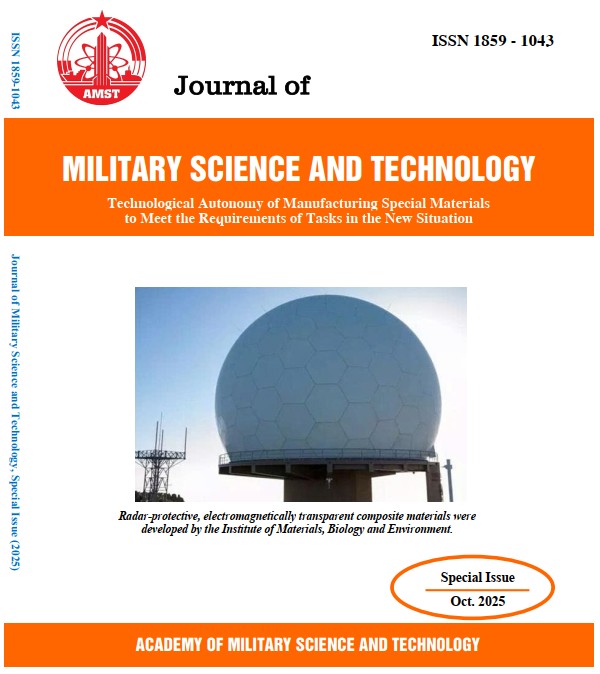Tiềm năng ứng dụng của sản phẩm IPFOS-Bacillus synbiotic trong bảo vệ sức khỏe bộ đội
DOI:
https://doi.org/10.54939/1859-1043.j.mst.IMBE.2025.158-164Từ khóa:
Synbiotic; Miễn dịch; Tiêu hóa; IPFOS-Bacillus.Tóm tắt
Prebiotic và probiotic được biết đến là có vai trò có lợi cho dinh dưỡng và sức khỏe con người. Trong nghiên cứu này, tác dụng của sản phẩm synbiotic IPFOS-Bacillus, một sản phẩm kết hợp của prebiotic-probiotic, đã được đánh giá về khả năng hỗ trợ tiêu hóa và điều hòa miễn dịch trên mô hình động vật. Việc sử dụng IPFOS-Bacillus với liều 37,2 mL/kg/ngày và 44,6 mL/kg/ngày đã làm giảm đáng kể tỷ lệ tiêu chảy và khôi phục sự cân bằng hệ vi sinh đường ruột (p < 0,05) ở chuột. Cả hai nồng độ sử dụng đều làm tăng lượng protein tổng số trong lách (p < 0,05) và số lượng tế bào lympho ở chuột bị gây tiêu chảy. Không có dấu hiệu bệnh lý bất thường nào được quan sát thấy ở tim, gan, thận, phổi, lách và hệ tiêu hóa. Những phát hiện này cho thấy IPFOS-Bacillus có tiềm năng to lớn trong danh sách các sản phẩm bảo vệ sức khỏe cho người lính cần được trang bị.
Tài liệu tham khảo
[1]. Valle, M.C.P.R. et al., “Immune status, well-being and gut microbiota in military supplemented with synbiotic ice cream and submitted to field training: a randomised clinical trial”, British Journal of Nutrition, 126(12), pp. 1794–1808, (2021).
[2]. Bineid, M.M. et al., “The effect of probiotics, prebiotics and synbiotics on gut microbial community profile in overweight and obese Latin American and Caribbean populations: a systematic review of human trials”, Gut Microbiome, 6, p. e2, (2025).
[3]. Yadav, M. et al., “Synbiotics as potent functional food: recent updates on therapeutic potential and mechanistic insight”, J Food Sci Technol, 61(1), pp. 1–15, (2024).
[4]. Payne, J. et al., “The Potential of Bacillus Species as Probiotics in the Food Industry: A Review”, Foods, 13(15), (2024).
[5]. Mazkour, S., S.S. Shekarforoush, and S. Basiri, “The effects of supplementation of Bacillus subtilis and Bacillus coagulans spores on the intestinal microflora and growth performance in rat”, Iran J Microbiol, 11(3), pp. 260–266, (2019).
[6]. Jäger, R. et al., “Probiotic Bacillus coagulans GBI-30, 6086 Improves Protein Absorption and Utilization”, Probiotics and Antimicrobial Proteins, 10(4), pp. 611–615, (2018).
[7]. Flore, T.N., Z.N. François, and T.M. Félicité, “Immune system stimulation in rats by Lactobacillus sp. isolates from Raffia wine (Raphia vinifera)”, Cell Immunol, 260(2), pp. 63–65, (2010).
[8]. Tripathi, N., M. Zubair, and A. Sapra, “Method of Gram Staining”, in StatPearls, The Station, (2025).
[9]. Slaoui, M. and L. Fiette, “Histopathology procedures: from tissue sampling to histopathological evaluation”, in Drug Safety Evaluation: Methods and Protocols, Springer, pp. 69–82, (2010).
[10]. Kruger, N.J., “The Bradford method for protein quantitation”, The Protein Protocols Handbook, pp. 17–24, (2009).
[11]. Aziz, T. et al., “Elucidating the role of diet in maintaining gut health to reduce the risk of obesity, cardiovascular and other age-related inflammatory diseases: recent challenges and future recommendations”, Gut Microbes, 16(1), p. 2297864, (2024).
[12]. Oyetayo, V., “Performance of rats orogastrically dosed with faecal strains of Lactobacillus acidophilus and challenged with Escherichia coli”, African Journal of Biotechnology, 3(8), pp. 409–411, (2004).
[13]. Chen, Y.-H. et al., “Synbiotics Alleviate Hepatic Damage, Intestinal Injury and Muscular Beclin-1 Elevation in Rats after Chronic Ethanol Administration”, International Journal of Molecular Sciences, 22(22), p. 12547, (2021).







